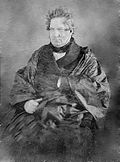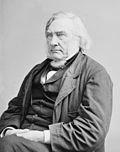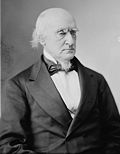Top Qs
Timeline
Chat
Perspective
List of United States Supreme Court cases, volume 59
From Wikipedia, the free encyclopedia
Remove ads
This is a list of cases reported in volume 59 (18 How.) of United States Reports, decided by the Supreme Court of the United States in 1855 and 1856.[1]
Remove ads
Nominative reports
In 1874, the U.S. government created the United States Reports, and retroactively numbered older privately-published case reports as part of the new series. As a result, cases appearing in volumes 1–90 of U.S. Reports have dual citation forms; one for the volume number of U.S. Reports, and one for the volume number of the reports named for the relevant reporter of decisions (these are called "nominative reports").
Benjamin Chew Howard
Starting with the 42nd volume of U.S. Reports, the Reporter of Decisions of the Supreme Court of the United States was Benjamin Chew Howard. Howard was Reporter of Decisions from 1843 to 1860, covering volumes 42 through 65 of United States Reports which correspond to volumes 1 through 24 of his Howard's Reports. As such, the dual form of citation to, for example, The Steamboat New York is 59 U.S. (18 How.) 223 (1856).
Remove ads
Justices of the Supreme Court at the time of 59 U.S. (18 How.)
Summarize
Perspective
The Supreme Court is established by Article III, Section 1 of the Constitution of the United States, which says: "The judicial Power of the United States, shall be vested in one supreme Court . . .". The size of the Court is not specified; the Constitution leaves it to Congress to set the number of justices. Under the Judiciary Act of 1789 Congress originally fixed the number of justices at six (one chief justice and five associate justices).[2] Since 1789 Congress has varied the size of the Court from six to seven, nine, ten, and back to nine justices (always including one chief justice).
When the cases in 59 U.S. (18 How.) were decided the Court comprised these nine members:
Remove ads
Citation style
Summarize
Perspective
Under the Judiciary Act of 1789 the federal court structure at the time comprised District Courts, which had general trial jurisdiction; Circuit Courts, which had mixed trial and appellate (from the US District Courts) jurisdiction; and the United States Supreme Court, which had appellate jurisdiction over the federal District and Circuit courts—and for certain issues over state courts. The Supreme Court also had limited original jurisdiction (i.e., in which cases could be filed directly with the Supreme Court without first having been heard by a lower federal or state court). There were one or more federal District Courts and/or Circuit Courts in each state, territory, or other geographical region.
Bluebook citation style is used for case names, citations, and jurisdictions.
- "C.C.D." = United States Circuit Court for the District of . . .
- e.g.,"C.C.D.N.J." = United States Circuit Court for the District of New Jersey
- "D." = United States District Court for the District of . . .
- e.g.,"D. Mass." = United States District Court for the District of Massachusetts
- "E." = Eastern; "M." = Middle; "N." = Northern; "S." = Southern; "W." = Western
- e.g.,"C.C.S.D.N.Y." = United States Circuit Court for the Southern District of New York
- e.g.,"M.D. Ala." = United States District Court for the Middle District of Alabama
- "Ct. Cl." = United States Court of Claims
- The abbreviation of a state's name alone indicates the highest appellate court in that state's judiciary at the time.
- e.g.,"Pa." = Supreme Court of Pennsylvania
- e.g.,"Me." = Supreme Judicial Court of Maine
List of cases in 59 U.S. (18 How.)
Remove ads
Notes and references
See also
External links
Wikiwand - on
Seamless Wikipedia browsing. On steroids.
Remove ads











